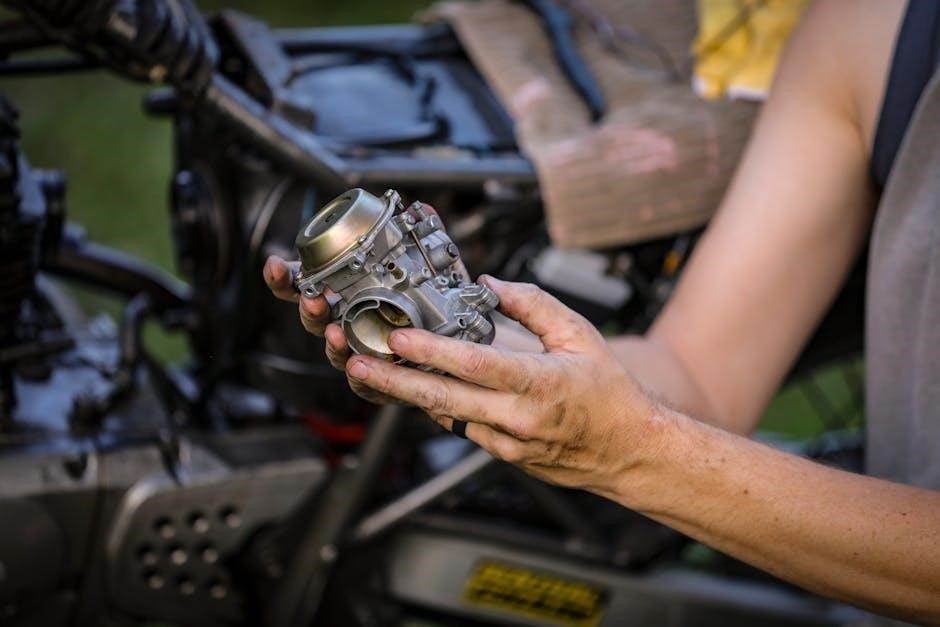Welcome to the Briggs Stratton 13․5 HP Engine Manual‚ your comprehensive guide for safe operation‚ maintenance‚ and troubleshooting․ This manual covers essential engine features‚ applications‚ and care tips to ensure optimal performance and longevity․
1․1 Overview of the Engine and Its Applications
The Briggs Stratton 13․5 HP engine is a reliable power source for various outdoor equipment‚ including lawn mowers‚ generators‚ and pressure washers․ Known for its durability and consistent performance‚ this engine is widely used in both residential and commercial settings․ Its compact design and efficient operation make it a popular choice for applications requiring medium to high power output․ The engine is built to handle demanding tasks while maintaining fuel efficiency and minimizing emissions․
1․2 Importance of Reading the Manual
Reading the Briggs Stratton 13․5 HP engine manual is crucial for safe and effective operation․ It provides detailed instructions for installation‚ maintenance‚ and troubleshooting‚ ensuring optimal performance․ Understanding safety precautions and proper usage can prevent accidents and extend the engine’s lifespan․ Familiarize yourself with the manual to avoid common mistakes and make informed decisions about repairs and servicing․ This guide is your key to maximizing efficiency and maintaining the engine’s reliability over time․

Safety Precautions and Warnings
Always wear protective gear‚ ensure a clear workspace‚ and secure loose clothing or jewelry․ Avoid operating the engine near children or unauthorized individuals․ Be cautious of hot surfaces and sharp edges to prevent injuries․
2․1 General Safety Guidelines
Always read the manual thoroughly before operating the engine․ Ensure the workspace is clear and well-ventilated․ Wear protective gear‚ including gloves and safety glasses․ Avoid loose clothing or jewelry that could get caught․ Keep children and unauthorized individuals away from the engine․ Be aware of hot surfaces‚ sharp edges‚ and moving parts․ Never operate the engine under the influence of alcohol or drugs․ Follow all safety labels and instructions provided by the manufacturer to ensure safe operation and minimize risks․
2․2 Hazards Associated with Engine Operation
Operating the Briggs Stratton 13․5 HP engine involves several hazards․ Rotating parts can cause severe injury‚ and engine overheating may lead to burns․ Exhaust emissions are harmful and should not be inhaled․ Fuel and oil leaks are potential fire hazards and environmental contaminants․ Always follow safety guidelines‚ ensure proper ventilation‚ and handle flammable materials cautiously․ Regular maintenance and adherence to manufacturer instructions are crucial to minimize these risks and ensure safe engine operation․
2․3 Safety Features of the Briggs Stratton 13․5 HP Engine
The Briggs Stratton 13․5 HP engine incorporates multiple safety features to protect users and prevent accidents․ These include protective shields for rotating parts‚ a secure ignition system to prevent unintended starts‚ and heat guards to minimize burns․ The engine is also designed with safety sensors to detect potential issues like overheating or oil pressure drops․ These features‚ combined with proper usage‚ help ensure a safer operating experience and reduce risks associated with engine operation․

Engine Installation Instructions
Proper installation ensures optimal performance and safety․ Follow pre-installation checks‚ step-by-step mounting‚ and alignment procedures․ Verify crankshaft alignment‚ secure all connections‚ and test the engine post-installation for functionality․
3;1 Pre-Installation Checks
Before installing the Briggs Stratton 13․5 HP engine‚ verify the model number matches your equipment․ Ensure all components‚ including the spark plug and air filter‚ are included․ Inspect for damage or wear․ Review safety guidelines to avoid hazards․ Check oil levels and fuel system integrity․ Confirm proper storage conditions and alignment specifications․ Ensure compatibility with your equipment’s mounting system․ Follow manual instructions for a secure and accurate installation process․
3․2 Step-by-Step Installation Process
- Mount the engine securely‚ ensuring proper alignment with the equipment it powers․
- Connect the spark plug wire and air filter according to the manual’s specifications․
- Attach the fuel line‚ ensuring no leaks or blockages․
- Add the recommended oil to the crankcase before starting․
- Connect the throttle and choke controls‚ if applicable․
- Start the engine and check for proper operation and any potential leaks․
3․3 Post-Installation Verification
After installation‚ perform a thorough inspection to ensure all components are securely connected․ Check for oil leaks‚ proper spark plug wire connection‚ and a snug air filter fit․ Test the throttle and choke controls for smooth operation․ Start the engine and let it run for a few minutes to verify smooth performance․ Refer to the manual for specific post-installation checks to ensure everything functions as intended․

Operating the Briggs Stratton 13․5 HP Engine
Learn to operate your engine safely and efficiently․ Understand throttle and choke controls‚ proper starting procedures‚ and monitoring techniques to ensure smooth and reliable performance․
4․1 Starting the Engine
To start the Briggs Stratton 13․5 HP engine‚ set the choke correctly․ Check the fuel level and air filter․ Prime the engine by pressing the primer bulb several times․ Pull the starter cord firmly until it starts․ Do not crank with the spark plug removed․ Allow the engine to warm up for a minute before adjusting the throttle for optimal performance․
4․2 Throttle and Choke Controls
The throttle and choke controls regulate engine performance․ Set the choke to “OPEN/RUN” after starting․ Use the throttle to adjust engine speed‚ optimizing power for varying loads․ Proper control ensures efficient operation and extends engine life․ Always follow manual guidelines for adjustments to maintain performance and safety․
4․3 Operating the Engine at Different Loads
Adjust the throttle to match workload demands․ For light loads‚ reduce engine speed to conserve fuel․ Increase RPM for heavier tasks‚ ensuring optimal power delivery․ Monitor engine performance to avoid overloading‚ which can cause overheating or reduced efficiency․ Maintain steady RPMs for consistent operation and extend engine lifespan․ Proper load management ensures reliable performance and minimizes wear on internal components․
Maintenance and Servicing
Regular maintenance ensures peak performance and longevity of your Briggs Stratton 13․5 HP engine․ This section covers essential servicing tasks‚ including oil changes‚ air filter cleaning‚ and spark plug maintenance‚ to keep your engine running smoothly and efficiently․
5․1 Recommended Maintenance Schedule
A regular maintenance schedule is crucial for the optimal performance of your Briggs Stratton 13․5 HP engine․ Oil changes should be performed every 8-10 hours of operation‚ while the air filter should be cleaned or replaced every 25 hours․ Spark plugs should be inspected and replaced every 100 hours‚ and the fuel system should be checked annually․ Adhering to this schedule ensures reliability‚ reduces wear‚ and prevents costly repairs‚ keeping your engine in prime condition for years․
5․2 Oil Change and Lubrication
Regular oil changes are essential for the longevity of your Briggs Stratton 13․5 HP engine․ Use high-quality detergent oil rated for small engines‚ preferably 10W-30 or 10W-40․ Drain the old oil after warming up the engine‚ then refill with the recommended type and amount․ Always check the oil level before starting the engine to ensure proper lubrication․ This routine helps prevent wear‚ reduces friction‚ and keeps the engine running smoothly under various operating conditions‚ ensuring optimal performance and extending its service life․
5․3 Air Filter Cleaning and Replacement
Regular air filter maintenance is crucial for your Briggs Stratton 13․5 HP engine’s performance․ Remove the air filter and clean it with mild soap and water․ Allow it to dry completely before reinstalling․ Inspect for damage or excessive wear; replace if necessary․ A dirty or damaged air filter can reduce engine power and efficiency․ Always ensure the air filter is properly seated to maintain optimal airflow and protect the engine from debris․ Replace the filter as recommended in the manual or sooner if operating in dusty conditions․
5․4 Spark Plug Maintenance
Regular spark plug maintenance is essential for optimal engine performance․ Remove the spark plug using a socket wrench and inspect for wear or fouling․ Clean the plug with a wire brush or replace it if damaged․ Ensure the spark plug gap meets the manufacturer’s specifications․ Reinstall the plug securely‚ tightening it to the recommended torque․ Replace spark plugs every 100 hours of operation or as specified in the manual to maintain proper ignition and engine efficiency․
5․5 Fuel System Maintenance
Regular fuel system maintenance ensures reliable engine performance․ Inspect fuel lines and connections for leaks or damage․ Replace worn or damaged components immediately․ Clean or replace the fuel filter as specified in the manual․ Use fresh‚ high-quality fuel to prevent contamination and corrosion․ Properly vent the fuel tank to avoid pressure buildup․ Regularly check the fuel system for blockages or debris․ Follow the manufacturer’s recommendations for fuel additives to maintain system health and efficiency․

Troubleshooting Common Issues
This section helps identify and resolve common engine problems‚ such as starting difficulties‚ overheating‚ or low power output‚ with practical solutions and diagnostic guidance․
6․1 Engine Not Starting
If the engine fails to start‚ check the spark plug for proper connection and condition․ Ensure the oil level is adequate and the choke is in the correct position․ Verify that the air filter is clean and not clogged․ If the engine is flooded‚ move the throttle to the open position and wait a few minutes before retrying․ Consult the troubleshooting guide for additional steps to diagnose and resolve the issue effectively․
6․2 Engine Overheating
Engine overheating can occur due to low oil levels‚ blocked air filters‚ or a malfunctioning cooling system․ Always check the oil level and top it off if necessary․ Clean or replace the air filter to ensure proper airflow․ Inspect the cooling system for blockages or damage․ Addressing these issues promptly can prevent damage to engine components and ensure reliable operation․ Refer to the maintenance section for detailed cooling system care instructions․
6․3 Low Power Output
Low power output can result from issues such as a clogged air filter‚ faulty spark plug‚ or improper fuel mixture․ Ensure the air filter is clean and the fuel system is free of debris․ Check the spark plug for wear or fouling and replace it if necessary․ Additionally‚ verify that the throttle and choke controls are functioning correctly․ Addressing these factors can restore the engine’s performance․ Consult the troubleshooting section for detailed diagnostic steps․
6․4 Oil Leaks
Oil leaks can occur due to loose connections‚ worn gaskets‚ or damaged seals․ Inspect the engine for any visible signs of leakage‚ particularly around the crankcase‚ oil drain plug‚ and filter․ Tighten any loose bolts or connections․ If leaks persist‚ replace the faulty gaskets or seals․ Regular maintenance‚ such as checking gasket condition and ensuring proper tightening torque‚ can prevent oil leaks․ Always turn off the engine and allow it to cool before inspecting or repairing․

Repair and Replacement Procedures
This section provides step-by-step guidance for repairing and replacing engine components․ Identify faulty parts‚ such as spark plugs or carburetors‚ and follow detailed instructions for replacement․ Ensure proper tools and genuine parts are used for reliable results and to maintain engine performance․ Regular repairs prevent major breakdowns and extend the engine’s lifespan․ Always refer to the manual for specific procedures and safety precautions․
7․1 Identifying Faulty Components
Identifying faulty components in your Briggs Stratton 13․5 HP engine is crucial for timely repairs․ Start by inspecting for visible signs of damage‚ wear‚ or leaks․ Check the spark plug for fouling or gaps‚ and ensure the air filter is clean․ Listen for unusual noises or vibrations that may indicate issues with internal components like piston rings or valves․ Use diagnostic tools to test fuel flow and ignition systems․ Refer to the troubleshooting section for specific symptoms and their corresponding component failures․ Regular inspections can prevent minor issues from becoming major problems․
7․2 Replacing the Spark Plug
To replace the spark plug in your Briggs Stratton 13․5 HP engine‚ start by disconnecting the spark plug wire․ Use a spark plug socket (13/16″) to remove the old plug․ Inspect the area for debris and clean if necessary․ Install the new spark plug‚ ensuring the gap is set to 0․030-0․035 inches․ Tighten securely but avoid overtightening․ Reconnect the spark plug wire and test the engine․ Always use a spark plug specified in the manual for your engine model to ensure proper performance and reliability․
7․3 Rebuilding the Carburetor
Rebuilding the carburetor on your Briggs Stratton 13․5 HP engine involves disassembling‚ cleaning‚ and replacing worn or damaged components․ Start by disconnecting the fuel line and removing the carburetor from the engine․ Soak the carburetor in a cleaning solution to remove dirt and debris․ Inspect the gaskets‚ jets‚ and float for wear․ Replace any damaged parts with genuine Briggs Stratton components․ Reassemble the carburetor‚ ensuring all connections are secure․ Reinstall and test the engine to ensure proper fuel flow and performance․ Always consult the manual for specific torque specifications and instructions․
7․4 Replacing the Air Filter
To replace the air filter on your Briggs Stratton 13․5 HP engine‚ start by locating the air filter housing‚ typically on the side or top of the engine․ Turn off the engine and allow it to cool․ Remove the housing cover by unscrewing the retaining clips or bolts․ Carefully pull out the old air filter and inspect it for dirt or damage․ Clean or replace the filter with a genuine Briggs Stratton part․ Reinstall the new filter‚ ensuring it is properly seated․ Replace the housing cover and secure it tightly․ Finally‚ check for any air leaks around the housing before restarting the engine․

Engine Parts and Accessories
Explore genuine Briggs Stratton parts and accessories for your 13․5 HP engine․ This section lists essential components‚ including air filters‚ spark plugs‚ and oil filters‚ ensuring optimal performance and longevity․
8․1 List of Common Parts
The Briggs Stratton 13․5 HP engine requires specific parts for optimal performance․ Common components include the air filter‚ spark plug‚ oil filter‚ fuel filter‚ and muffler․ The engine may also need a carburetor‚ ignition coil‚ and valve assembly․ Genuine parts ensure reliability and longevity․ Refer to your engine’s model number (e․g․‚ 130200-130299) to identify exact components; Always use Briggs Stratton-approved accessories for compatibility and safety․ These parts are widely available at authorized dealers or online retailers․
8․2 Where to Buy Genuine Parts
For the Briggs Stratton 13․5 HP engine‚ genuine parts are available through the official Briggs Stratton website or authorized dealers․ Visit their online store or use the dealer locator tool to find a service center near you․ Additionally‚ reputable online retailers like Amazon or eBay may carry authentic components․ Always verify the seller’s authenticity to ensure parts are genuine and compatible with your engine model․ Purchasing from authorized sources guarantees warranty coverage and optimal performance․
8․3 Accessories for Enhanced Performance
To maximize the performance of your Briggs Stratton 13․5 HP engine‚ consider adding high-quality accessories․ Performance mufflers can reduce noise while improving exhaust flow․ High-performance pistons and rings enhance compression and power output․ Advanced ignition systems‚ such as electronic ignition kits‚ provide a stronger spark for better combustion․ Additionally‚ performance-grade air filters and fuel additives can optimize engine efficiency․ These accessories are designed to boost your engine’s power‚ reliability‚ and overall performance under various operating conditions․

Environmental and Storage Considerations
Properly store the engine in a dry‚ cool place‚ away from flammable materials․ Dispose of used oil and filters responsibly․ Follow eco-friendly practices to minimize environmental impact․
9․1 Proper Storage Techniques
Store the engine in a cool‚ dry place‚ away from direct sunlight and flammable materials․ Drain the fuel tank to prevent stale gas․ Clean the engine thoroughly to remove dirt and debris․ Disconnect the spark plug wire for safety․ Check for oil leaks and address them before storage․ Use a breathable cover to protect from dust and moisture․ Ensure the storage area is well-ventilated to prevent condensation buildup․ Proper storage ensures the engine remains in good condition for future use․
9․2 Disposal of Used Engine Oil and Filters
Dispose of used engine oil and filters responsibly to protect the environment․ Do not drain oil into storm drains or trash․ Take used oil and filters to a recycling center or an authorized service provider․ Ensure oil is contained in leak-proof containers to prevent spills․ Check local regulations for specific disposal guidelines․ Proper disposal helps prevent environmental contamination and promotes sustainability․ Always prioritize eco-friendly practices when handling engine waste․
9․3 Environmental Impact of Engine Operation
Operating the Briggs Stratton 13․5 HP engine can impact the environment through emissions and oil spills․ Regular maintenance‚ such as proper tune-ups and oil changes‚ reduces emissions․ Use eco-friendly practices to minimize ecological effects․ Always follow local environmental guidelines for engine operation and waste disposal․ By adhering to these practices‚ you can help reduce the engine’s environmental footprint and promote sustainability․ Proper care ensures responsible use of natural resources and contributes to a cleaner planet․

Downloading the Manual
Visit the official Briggs Stratton website‚ locate your engine model number‚ and follow the step-by-step guide to download the PDF manual․ Ensure proper navigation for easy access to all sections and troubleshooting guides․
10․1 Finding the Correct Model Number
To download the correct manual‚ locate the engine model number on the Briggs Stratton 13․5 HP engine label․ This number is typically 10-12 digits long and may start with “13” for this specific model․ Visit the official Briggs Stratton website and navigate to the “Manuals” section․ Enter the model number in the search bar to ensure you access the precise guide for your engine․ Accurate model identification is crucial for proper installation‚ operation‚ and maintenance instructions․
10․2 Step-by-Step Download Process
Visit the official Briggs Stratton website and navigate to the “Manuals” section․ Enter your engine model number in the search bar․ Select your specific model from the results․ Click the “Download” button to access the PDF manual․ Ensure the model number matches your engine to guarantee accurate information․ Follow the prompts to complete the download․ Save the file for easy reference․ This step-by-step process ensures you obtain the correct manual for your Briggs Stratton 13․5 HP engine․
10․3 Navigating the PDF Manual
The PDF manual is organized into clear sections for easy navigation․ Use bookmarks to jump to specific topics like maintenance‚ troubleshooting‚ or parts lists․ The table of contents provides quick access to key sections․ Utilize the search function to find specific terms or procedures․ Zoom in for detailed views of diagrams or charts․ Save the manual for offline access and refer to it regularly for guidance on engine operation and care․

Warranty and Support
This section outlines the warranty terms for your Briggs Stratton 13․5 HP engine‚ providing details on coverage duration and conditions․ It also explains how to contact customer support and locate authorized service centers for assistance․
11․1 Understanding the Warranty Terms
This section explains the warranty coverage for your Briggs Stratton 13․5 HP engine‚ including the duration and conditions of the warranty․ It outlines what is covered under the warranty‚ such as parts and labor‚ and highlights any exclusions or limitations․ Understanding the warranty terms is essential to ensure you receive the full benefits of your engine’s coverage․ Always review the warranty details in the manual to avoid any misunderstandings or voiding the warranty due to improper use or maintenance․
11․2 Contacting Briggs Stratton Support
Contacting Briggs Stratton Support is essential for resolving issues or seeking guidance․ You can reach their team via phone‚ email‚ or live chat through their official website․ The support team is available to assist with troubleshooting‚ repair inquiries‚ and warranty-related questions․ Ensure you have your engine model number ready for efficient assistance․ Their dedicated support ensures you receive accurate and timely help to maintain your engine’s performance and address any concerns effectively․ Visit their website for detailed contact information and support options․
11․3 Service Centers and Authorized Dealers
For professional assistance‚ locate authorized Briggs Stratton service centers or dealers near you․ These centers offer expert repair‚ maintenance‚ and genuine parts for your 13․5 HP engine․ Visit the official Briggs Stratton website to use their service center locator tool․ Authorized dealers ensure high-quality service‚ adhering to manufacturer standards․ They provide diagnostics‚ repairs‚ and routine maintenance to keep your engine running efficiently․ Utilize these resources for reliable support and genuine parts‚ ensuring your engine operates at peak performance for years to come․
12․1 Summary of Key Points
This manual provides a comprehensive guide for the Briggs Stratton 13․5 HP engine‚ covering installation‚ operation‚ maintenance‚ and troubleshooting․ It emphasizes safety precautions‚ proper usage of controls‚ and regular servicing to ensure optimal performance․ Key points include following the recommended maintenance schedule‚ addressing common issues promptly‚ and understanding warranty terms․ By adhering to the instructions‚ users can maximize engine longevity‚ efficiency‚ and safety․ This guide is an essential resource for both new and experienced users․
12․2 Final Tips for Engine Longevity
To ensure the Briggs Stratton 13․5 HP engine lasts for years‚ follow these final tips: always adhere to the recommended maintenance schedule‚ use genuine parts‚ and store the engine properly․ Regularly check oil levels‚ clean the air filter‚ and avoid extreme loads․ Keep the engine area clean and dry to prevent rust․ Address any issues promptly to avoid costly repairs․ By following these guidelines‚ you can maximize the engine’s performance‚ reliability‚ and lifespan while maintaining safety and efficiency․







